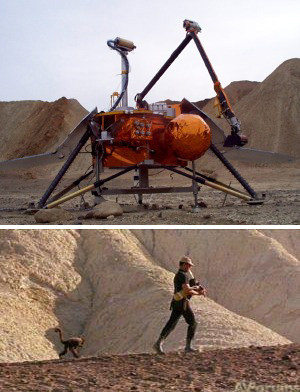 Mockup of Phoenix (top) and 'Robinson Crusoe on Mars'
Mockup of Phoenix (top) and 'Robinson Crusoe on Mars'
(bottom)—both set in Death Valley National Park…
Credit: NASA (top), Paramount Pictures (bottom)It's that time of the Martian year again: when a flying saucer from Earth appears in the skies of Mars. Imagine if there actually were Martians up there: what's science fiction here on Earth would pass for reality on the Red Planet—and a routine occurrence at that!
This time the flavor of the day is the Phoenix Lander, courtesy of NASA, scheduled to land on May 25th at about 4:38 PM PDT. We'll be watching live NASA coverage of the landing at Chabot Space & Science Center that afternoon, if you'd care to join us…
Following somewhat in the footsteps of the Viking landers of the 1970s, Phoenix's primary mission is to look for evidence of life, or at least the chemical conditions that might be suitable for life to exist. The two Viking landers carried small chemical laboratories that analyzed soil samples scooped up from the surface, as does Phoenix.
While its mission parallels that of Viking, one big difference from Phoenix is its destination: the Northern Polar Ice Cap of Mars. The Vikings landed much farther south in the mid latitudes. Phoenix is targeting the ices of Mars' arctic region.
Growing up, one of my favorite sci-fi films was Robinson Crusoe on Mars. Made in 1964, the same year that Mariner 4, the first space probe to Mars, was launched, RCOM made a descent stab at imagining what it was like. So what if the main character walked around in apparent t-shirt weather and with sufficient atmospheric pressure to keep his blood from boilin--he still wore a respirator that doled out oxygen from an ever-dwindling supply tank, a nod to Mars' thin atmosphere.
